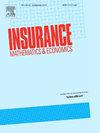基于变压器的寿险偿付能力最小二乘蒙特卡罗计算
IF 2.2
2区 经济学
Q2 ECONOMICS
引用次数: 0
摘要
偿付能力资本要求(SCR),由偿付能力II授权,代表保险公司必须持有以确保偿付能力的资本,计算为净资产价值的风险价值,在一年的时间内以99.5%的置信度计算。虽然嵌套蒙特卡罗模拟是SCR计算的黄金标准,但它们是高度资源密集型的。最小二乘蒙特卡罗(LSMC)方法提供了一种更有效的替代方法,但由于维度的限制,它在处理高维数据时面临挑战。我们引入了LSMC的新扩展,结合了先进的深度学习模型,特别是Transformer模型,它增强了传统的机器学习方法。该方法显著提高了近似保险责任与风险因素之间复杂关系的准确性,从而使SCR的计算更加准确。我们在两个保险组合上的大量实验证明了这种基于变压器的LSMC方法的有效性。此外,我们表明Shapley值可以应用于实现模型的可解释性,这对于法规遵从性和促进在高度监管的保险行业采用深度学习至关重要。本文章由计算机程序翻译,如有差异,请以英文原文为准。
Transformers-based least square Monte Carlo for solvency calculation in life insurance
The Solvency Capital Requirement (SCR), mandated by Solvency II, represents the capital insurers must hold to ensure solvency, calculated as the Value-at-Risk of the Net Asset Value at a 99.5% confidence level over a one-year period. While Nested Monte Carlo simulations are the gold standard for SCR calculation, they are highly resource-intensive. The Least Squares Monte Carlo (LSMC) method provides a more efficient alternative but faces challenges with high-dimensional data due to the curse of dimensionality. We introduce a novel extension of LSMC, incorporating advanced deep learning models, specifically Transformer models, which enhance traditional machine learning methods. This approach significantly improves the accuracy of approximating the complex relationship between insurance liabilities and risk factors, leading to a more accurate SCR calculation. Our extensive experiments on two insurance portfolios demonstrate the effectiveness of this transformer-based LSMC approach. Additionally, we show that Shapley values can be applied to achieve model explainability, which is crucial for regulatory compliance and for fostering the adoption of deep learning in the highly regulated insurance sector.
求助全文
通过发布文献求助,成功后即可免费获取论文全文。
去求助
来源期刊

Insurance Mathematics & Economics
管理科学-数学跨学科应用
CiteScore
3.40
自引率
15.80%
发文量
90
审稿时长
17.3 weeks
期刊介绍:
Insurance: Mathematics and Economics publishes leading research spanning all fields of actuarial science research. It appears six times per year and is the largest journal in actuarial science research around the world.
Insurance: Mathematics and Economics is an international academic journal that aims to strengthen the communication between individuals and groups who develop and apply research results in actuarial science. The journal feels a particular obligation to facilitate closer cooperation between those who conduct research in insurance mathematics and quantitative insurance economics, and practicing actuaries who are interested in the implementation of the results. To this purpose, Insurance: Mathematics and Economics publishes high-quality articles of broad international interest, concerned with either the theory of insurance mathematics and quantitative insurance economics or the inventive application of it, including empirical or experimental results. Articles that combine several of these aspects are particularly considered.
 求助内容:
求助内容: 应助结果提醒方式:
应助结果提醒方式:


